Are you trying to build a brand that truly stands for sustainability? It can be frustrating when your products don’t tell a consistent story, leaving customers confused. A cohesive eco-friendly tableware collection is your chance to make a powerful statement and capture the hearts of green consumers.
To design a cohesive eco-friendly tableware collection, you must focus on three core areas. First, select a primary sustainable material, like bagasse or bamboo, to create a unified look and feel. Second, apply minimalist design principles that emphasize the material’s natural beauty. Finally, develop a consistent brand story and packaging that clearly communicates your commitment to the planet, building trust and recognition with your customers.
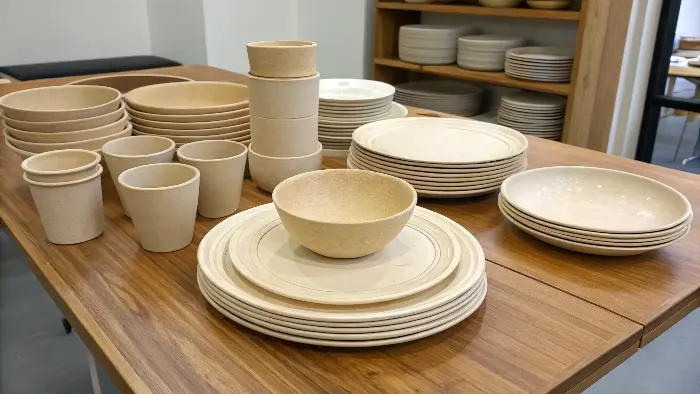
Building a beautiful collection is one thing, but understanding the ‘why’ and ‘how’ behind it is what truly sets a brand apart from the competition. It’s about more than just selling a product; it’s about leading a movement and making it easy for your customers to be a part of it. Let’s break down the key elements you need to consider, starting with the massive opportunity waiting for you.
How big is the biodegradable tableware market?
Are you worried that investing in eco-friendly tableware might be a risky bet? This hesitation can cause you to miss out on a rapidly expanding market, allowing your competitors to get ahead. Understanding the sheer scale and growth of this industry will give you the confidence to invest decisively.
The global biodegradable tableware market is a multi-billion dollar industry and is projected to grow substantially over the next decade. This explosive growth is fueled by increasing consumer demand for sustainable products and government regulations banning single-use plastics. For any business, this represents a golden opportunity to capture market share, meet customer expectations, and build a future-proof brand.
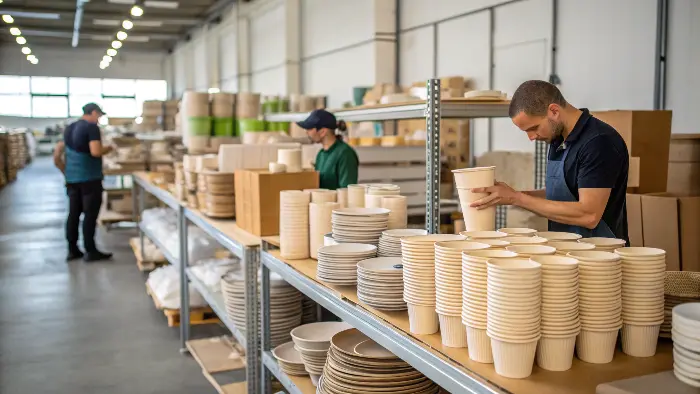
When I first started in this industry, many people saw "eco-friendly" as a small, niche market. Today, it’s a global powerhouse. The numbers don’t lie. We’re seeing double-digit annual growth in many regions, and this isn’t a short-term trend. It’s a fundamental shift in consumer behavior and corporate responsibility.
Key Market Drivers
The growth is not happening by accident. Several factors are pushing this market forward.
- Consumer Awareness: People are more educated than ever about plastic pollution. They actively seek out brands that align with their values. A study I recently read showed that over 60% of consumers are willing to pay more for sustainable products.
- Government Regulations: Countries and cities worldwide are implementing bans on single-use plastics. This forces businesses in the food service and hospitality industries to find alternatives, and biodegradable tableware is the leading solution.
- Corporate Sustainability Goals: Large corporations are setting ambitious sustainability targets. As a supplier, being able to provide certified eco-friendly products makes you an invaluable partner for them.
Here’s a simple breakdown of the forces at play:
| Market Drivers | Market Challenges |
|---|---|
| Strong consumer demand for green products | Higher initial cost compared to plastic |
| Government bans on single-use plastics | Misconceptions about product performance |
| Corporate ESG (Environmental, Social) goals | Need for proper composting infrastructure |
| Positive brand image and marketing benefits | Navigating different international standards |
From my experience working with partners in North America and Europe, the demand is undeniable. Clients like Jacky in Canada aren’t just looking for a product; they’re looking for a reliable partner who understands the market and can help them navigate these challenges. This isn’t just about selling plates and cutlery; it’s about providing a solution to a global problem.
How are eco-friendly items actually made?
The term "eco-friendly" sounds great, but it can also feel vague and confusing. If you don’t understand the manufacturing process, you can’t confidently choose the right products or explain their value to your customers. Let’s pull back the curtain and simplify how these amazing items are created.
Making eco-friendly items begins with sourcing renewable raw materials like sugarcane bagasse, bamboo, or corn-based PLA. These materials are then processed using methods that minimize energy and water consumption. The final product is designed for a clean end-of-life, ensuring it is fully compostable or biodegradable, a claim verified by certifications like BPI or TÜV Austria.
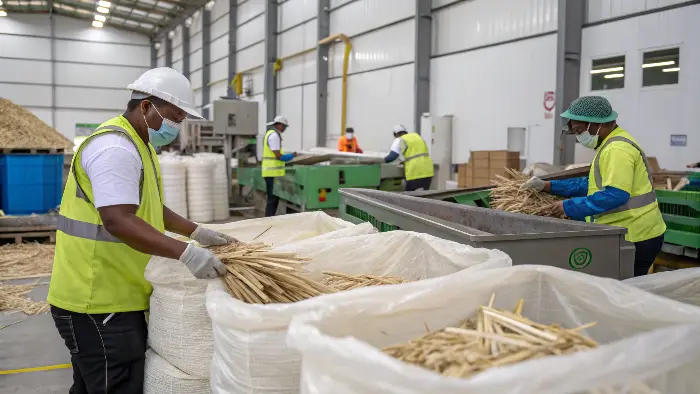
I’ve visited dozens of factories over the years, and the innovation in this space is incredible. It’s a journey from farm to table, but in a completely new way. The process is a testament to how we can use natural byproducts and smart science to create everyday items without harming the planet.
Material Selection is Key
Everything starts with the right material. Unlike plastic, which comes from finite fossil fuels, our materials are plant-based and renewable.
- Sugarcane Bagasse: This is the fibrous pulp left over after juice is extracted from sugarcane. Instead of being burned or discarded, this waste product is turned into durable, microwave-safe, and compostable plates and containers.
- PLA (Polylactic Acid): This is a bioplastic made from fermented plant starch, usually from corn. It’s perfect for creating clear cups, lids, and cutlery that look and feel like traditional plastic but are commercially compostable.
- Bamboo: As one of the fastest-growing plants on Earth, bamboo is an incredibly sustainable resource. It’s used to make sturdy, reusable-feeling cutlery, plates, and coffee cups.
The Manufacturing Process
Once the raw material is chosen, it’s transformed. For bagasse, the pulp is mixed with water to create a slurry. This slurry is then poured into molds, pressed at high temperatures to remove water, and shaped into the final product. The process for PLA involves melting resin pellets and using injection molding or thermoforming, similar to plastic but with a much lower carbon footprint. The key is efficiency—using less water, less energy, and creating zero waste.
End-of-Life Planning
This is the most critical part. A product is only truly eco-friendly if it has a responsible end-of-life. This is where certifications become non-negotiable. Standards like ASTM D6400 in the US and EN13432 in Europe guarantee that a product will break down into natural elements in a commercial composting facility within a specific timeframe. Without these certifications, a "biodegradable" claim is just a word.
Here’s a quick comparison of the top materials:
| Feature | Sugarcane Bagasse | PLA (Corn Starch) | Bamboo |
|---|---|---|---|
| Source | Agricultural waste (sugarcane) | Renewable resource (corn) | Rapidly growing plant |
| Heat Resistance | Excellent (hot foods, microwave) | Good (best for cold items) | Very Good (hot and cold) |
| End-of-Life | Commercially Compostable | Commercially Compostable | Commercially Compostable |
| Best For | Plates, bowls, clamshell containers | Cups, cutlery, clear containers | Cutlery, coffee cups, reusable items |
Understanding this process helps you build a better collection. You can choose the right material for each product’s function, creating a cohesive line that is not only beautiful but also highly practical and genuinely sustainable.
How should you design eco-friendly packaging?
You’ve sourced a fantastic eco-friendly product, but it arrives in a plastic wrap or an oversized box. This contradiction instantly breaks the trust you’re trying to build with your customer. Your packaging must be an extension of your product’s promise, not a contradiction to it.
To design effective eco-friendly packaging, you must embrace minimalism. Use the least amount of material possible, such as a simple kraft paper sleeve instead of a full box. Choose materials that are recycled, recyclable, or compostable. Most importantly, use the design to clearly communicate disposal instructions, empowering your customer to complete the product’s sustainable lifecycle.
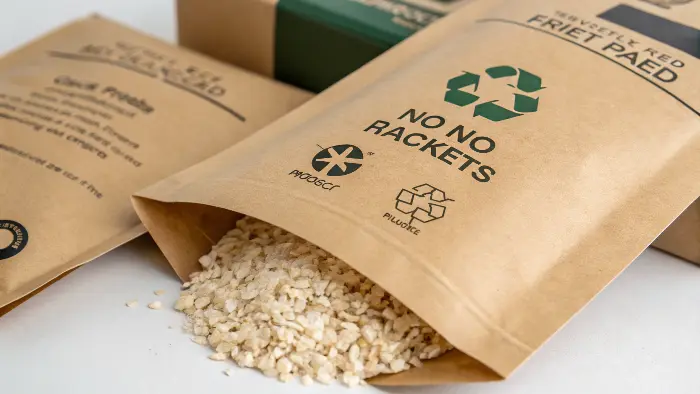
I remember working with a client who sold beautiful bamboo cutlery sets. They were packaged in a clear plastic clamshell. We redesigned it to use a single, printed band of recycled paper that held the set together. Not only did it cut their packaging costs by 40%, but their customers loved it. It showed they were thinking about every single detail.
Material Choices for Packaging
The material is your first and most important decision. You want to choose something that aligns with the product inside.
- FSC-Certified Paper & Cardboard: This ensures the paper comes from responsibly managed forests. It’s a powerful signal to consumers.
- Recycled Content: Using post-consumer recycled paper or cardboard reduces waste and the need for virgin materials.
- Vegetable-Based Inks: Standard inks are petroleum-based. Switching to soy or other vegetable-based inks is a small change that makes a big difference.
Structural Design for Minimalism
Less is more. The goal is to protect the product with the smallest environmental footprint possible.
- Reduce Layers: Do you really need an inner wrap, a box, and an outer sleeve? Often, one well-designed piece is enough.
- Smart Folds, Not Glue: Clever structural design can create a sturdy box that locks together without needing toxic adhesives.
- Design for Shipping: Designing packaging that ships flat and is assembled by the user can drastically reduce the carbon footprint of transportation.
Communicating Green Credentials
Your packaging is your billboard. Use it to educate your customer. Simple, universally recognized icons for "compostable" or "recyclable" are essential. Add a short, clear sentence like, "This sleeve is made from 100% recycled paper and can be recycled again." This transparency builds immense trust.
Here’s how different packaging choices stack up:
| Packaging Option | Environmental Impact | Brand Perception |
|---|---|---|
| Plastic Clamshell | High (Fossil Fuels) | Outdated, irresponsible, cheap |
| Recycled Cardboard Box | Low (Circular) | Responsible, modern, thoughtful |
| Kraft Paper Sleeve | Very Low (Minimalist) | Innovative, confident, premium, eco-conscious |
Your packaging design isn’t an afterthought. It’s a critical part of the customer experience and a powerful tool for telling your brand’s story.
How does environmentally friendly packaging contribute to a brand’s image?
Do you view sustainable packaging as just another expense on your balance sheet? This perspective is a major blind spot. It causes you to miss one of the most powerful opportunities you have to connect with customers, build loyalty, and define what your brand stands for.
Eco-friendly packaging directly strengthens your brand’s image by providing tangible proof of your commitment to sustainability. This builds deep trust with consumers who are actively looking for responsible companies. This positive perception translates into greater customer loyalty, powerful word-of-mouth marketing, and a clear advantage over competitors who are still using traditional, wasteful packaging.
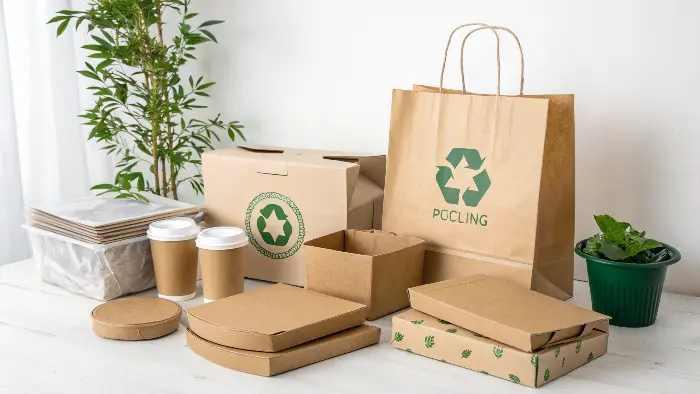
Think about the last time you received a product. The packaging was your first physical interaction with that brand. It set the tone for your entire experience. When that packaging is thoughtful, minimal, and sustainable, it sends a clear message: this brand cares. It cares about the planet, and it cares about delivering a quality experience to you.
Building Trust and Authenticity
In today’s market, consumers are skeptical of "greenwashing"—brands making false or exaggerated environmental claims. Your packaging is your proof. When a customer holds a box made from recycled materials or a sleeve printed with soy ink, your sustainability claims become real and believable. It’s not just talk; it’s action. This authenticity is the foundation of a long-lasting customer relationship. I’ve seen brands transform their reputation simply by overhauling their packaging to align with their stated values.
The Unboxing Experience as Marketing
The "unboxing" moment is huge. People film it, they share it on social media, they talk about it. A beautiful, sustainable unboxing experience is free marketing. It makes the customer feel good about their purchase, reinforcing their decision to choose you. They become brand advocates, sharing their positive experience with their network. This organic reach is far more powerful than any paid advertisement.
Differentiating from the Competition
Imagine a store shelf filled with products in shiny plastic packaging. Your product, in its elegant, earthy, kraft paper box, immediately stands out. It signals quality, care, and modernity. It attracts the exact customer you want—someone who is thoughtful and willing to invest in brands that share their values.
Here’s how a simple packaging switch can redefine your brand’s attributes:
| Brand Attribute | With Traditional Plastic Packaging | With Eco-Friendly Packaging |
|---|---|---|
| Trustworthy | Questionable, "greenwashing" risk | High, authentic, transparent |
| Innovative | Standard, behind the times | Forward-thinking, modern, leader |
| Premium | Can look cheap and generic | Thoughtful, high-quality, detail-oriented |
| Responsible | Low, disconnected from values | High, committed, mission-driven |
For a brand specialist like Jacky, these attributes are everything. He knows that the packaging isn’t just a container; it’s the silent salesperson for the product. Investing in eco-friendly packaging isn’t a cost. It’s an investment in building a stronger, more resilient, and more beloved brand.
Conclusion
Creating a cohesive eco-friendly tableware collection is a powerful business strategy. The market is growing rapidly, the manufacturing process is accessible, and the impact on your brand image is undeniable. By focusing on sustainable materials, minimalist design, and transparent storytelling, you build a brand that customers trust and admire.


